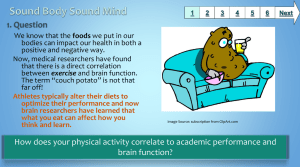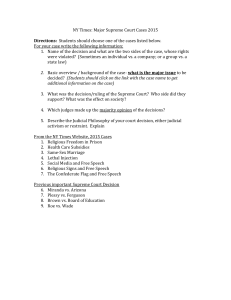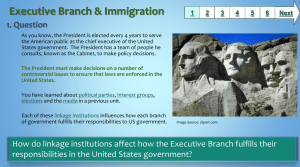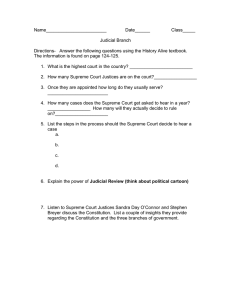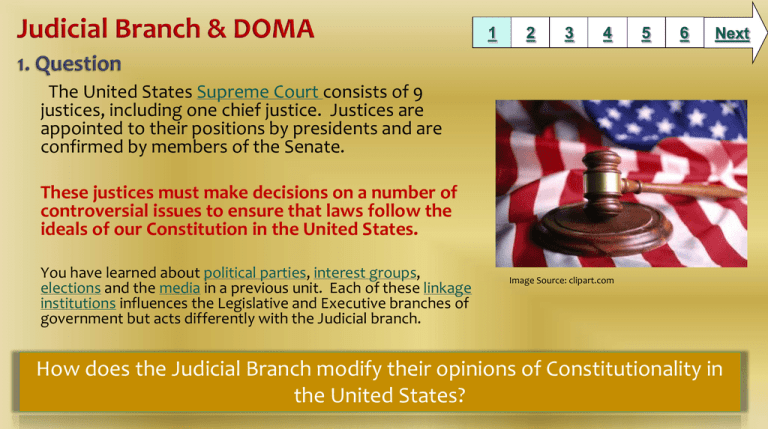
1
2
3
4
5
6
Next
The United States Supreme Court consists of 9
justices, including one chief justice. Justices are
appointed to their positions by presidents and are
confirmed by members of the Senate.
These justices must make decisions on a number of
controversial issues to ensure that laws follow the
ideals of our Constitution in the United States.
You have learned about political parties, interest groups,
elections and the media in a previous unit. Each of these linkage
institutions influences the Legislative and Executive branches of
government but acts differently with the Judicial branch.
Image Source: clipart.com
How does the Judicial Branch modify their opinions of Constitutionality in
the United States?
1
2
3
4
5
6
Next
The Supreme Court should be an entity that is not influenced by the
linkage institutions that you have previously learned about. However,
over time, the opinion of the Supreme Court can change based on
changing public opinion. By choosing the Defense of Marriage Act, you
can investigate how the Supreme Court changes based on which political
party is in control of the Congress, which President appoints them to the
bench and how the media changes their ideas on topics.
Political Parties
Split Definitive
Influence and Independence: Politics in Supreme Court Decisions
Elections
Biographies of Supreme Court Justices
NBC Learn – Hillary Clinton’s Gay Marriage Stance Sparks 2016 Rumors
Media
NBC Learn – Supreme Court to hear Two Challenges on Gay Marriage
NBC Learn – Supreme Court May Strike Down DOMA
NBC Learn – Supreme Court Rulings Bolster Gay Marriage
Image Source: clipart.com by subscription
Everything you would ever want
to learn about DOMA from the
Chicago-Kent College of Law.
Public Interest Law Groups
Appearing frequently before the
Court
1
2
3
4
Using the resources on the
previous slide, create your own
notes pages or use the following to
organize your ideas about how the
Judicial Branch changes their
opinions based on changes
occurring in the linkage institutions:
One-Pager
Image Source: wordle created by author of Slam Dunk
5
6
Next
1
2
3
4
5
6
Next
Use your notes to create a voki describing how
the Judicial Branch made the decision regarding
the Defense of Marriage Act.
How does the Judicial Branch modify their opinions of
Constitutionality in the United States?
Be sure to include the following in your vokis:
How were the linkage institutions mentioned on the
resource page involved in the creation and defeat of
DOMA?
How does that linkage institution impact how the
Judicial branch conducts their business of interpreting
laws?
Follow the rubric to earn an A!
Image Source: clipart.com by subscription
1
2
3
4
5
6
There are a number of games that you can
play to virtually participate in court
decisions.
We the Jury
Argument Wars
Court Quest
Image Source: clipart.com by subscription
Do I have the Right?
Supreme Decision
Next
1
BCPS Curriculum
Unit 7 – The Federal Judiciary Indicator 1: Students will analyze the structures and powers of the federal judiciary in order to evaluate its
impact on the political process. (IV-AB) Objective 7: Analyze the relationship between the court and linkage institutions.
Maryland State Curriculum
1. The student will demonstrate understanding of the structure and functions of government and politics in the United States B.
Individual and Group Participation in the Political System Indicator 1. The student will explain roles and analyze strategies individuals or
groups may use to initiate change in governmental policy and institutions (1.1.4). b. Analyze the external factors that influence the lawmaking process including the roles of the media, lobbyists, Political Action Committees (PACs), special-interest groups, citizens and public
opinion (Unit 3) d. Evaluate how the media, political parties, special-interest groups, lobbyists, Political Action Committees (PACs)
influence public opinion and government policies k. Analyze various methods that individuals or groups may use to influence laws and
governmental policies including petitioning, letter writing and acts of civil disobedience (Unit 7)
Common Core State Standards
CCSS.ELA-Literacy.RH.9-10.1 Cite specific textual evidence to support analysis of primary and secondary sources, attending to such
features as the date and origin of the information.
CCSS.ELA-Literacy.RH.9-10.3 Analyze in detail a series of events described in a text; determine whether earlier events caused later ones or
simply preceded them.
CCSS.ELA-Literacy.RH.9-10.9 Compare and contrast treatments of the same topic in several primary and secondary sources.
CCSS.ELA-Literacy.WHST.9-10.2 Write informative/explanatory texts, including the narration of historical events, scientific procedures/
experiments, or technical processes.
CCSS.ELA-Literacy.WHST.9-10.6 Use technology, including the Internet, to produce, publish, and update individual or shared writing
products, taking advantage of technology’s capacity to link to other information and to display information flexibly and dynamically.
CCSS.ELA-Literacy.WHST.9-10.7 Conduct short as well as more sustained research projects to answer a question (including a selfgenerated question) or solve a problem; narrow or broaden the inquiry when appropriate; synthesize multiple sources on the subject,
demonstrating understanding of the subject under investigation.
Standards for the 21st Century Learner
1.1.6 Read, view, and listen for information presented in any format (e.g. textual, visual, media, digital) in order to make inferences and
gather meaning.
2.1.3 Use strategies to draw conclusions from information and apply knowledge to curricular areas, real-world situations, and further
investigations.
Maryland Technology Literacy Standards for Students
3.0: Use a variety of technologies for learning and collaboration.
2
3
4
5
6
Time Frame: 1 90 minute class period
Differentiation: Each graphic organizer can be created by the
students - does not need to use the provided resources.
Databases have text-to-speech features for some
articles. Teacher can choose to divide students in class
by linkage institution and have students create
Infographic on 1 institution.
Learning Styles: Field Dependent, Field Independent, Visual,
Auditory, Tactile, Reflective, Global
AVID Strategies:
inquiry based learning, one pager, rubric
Notes to the teacher:
Consult with your School Library Media Specialist to
implement this Slam Dunk Lesson.
Students can turn in activities by saving one pager and
copying it to your school’s student drive/printing and turning
in.
Last updated: July 2015
Created by Jamie Higgins Shaull, Department Chair – Social Studies/Library Media Intern
BCPS Slam Dunk Research Model, Copyright 2013, Baltimore County Public Schools, MD, all rights reserved. The models may be used for educational, non-profit school use only.
All other uses, transmissions, and duplications are prohibited unless permission is granted expressly. This lesson is based on Jamie McKenzie’s Slam Dunk Lesson module.


